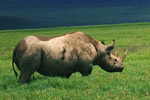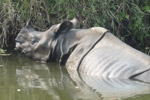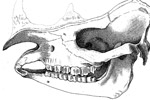WARNING: graphic image below.
Last week, visitors in Kruger National Park came on a horrifying sight of the poaching trade: a rhino, still alive, with its horn and part of its face chopped off. The gruesome photo of the young rhino went viral and sent South African authorities scrambling. Five days after the sighting, South African National Parks (SANParks) has announced they found the rhino and put it out of its misery.
“An assessment was conducted to determine the extent of the injuries and suffering. It was discovered that a bullet had lodged in the rhino’s brain and therefore any chance of survival was slim,” said Reynold Thakhuli, Head of Communications, adding, “People must be able to understand that our main task is conservation, but if you look at the pain that it endured we had to end its suffering. Its brain had been affected by the bullet, as well as one eye.”
South Africa is in the midst of a rhino poaching epidemic. Last year, the country lost 1,004 rhinos to poachers. This year, already, 146 rhinos have been killed, not counting this most recent individual. At this pace, South Africa is losing more than two rhinos a day on average, worse stats than anywhere else in the world.
Rhinos are killed by criminals for their horns, which are ground up and used in traditional Chinese medicine as a curative. However, scientific research has found that rhino horn has no medicinal value. The consumption of rhino horn is also increasingly seen as a status symbol in places like Vietnam, according to recent studies.
South Africa is home to more rhinos than any other country, including around 19,000 white rhinos (Ceratotherium simum) and 2,000 black rhinos (Diceros bicornis), the latter of which is considered Critically Endangered. But even as poaching has boomed in South Africa, some countries have seen more success protecting their populations. For example, Namibia has only experienced a few poaching incidents in recent years, despite being home to around 2,250 rhinos (including both white and black). Meanwhile, Nepal just celebrated a full twelve months without losing a single rhino (or tiger and elephant for that matter). Nepal is home to over 500 Indian rhinos (Rhinoceros unicornis), also known as greater one-horned rhinos .

Young rhino whose horn and part of its face cut off by poachers. The animal survived for several days before South African officials found it and put it down. Photo by: Frans Lombard, shared on Facebook.
Video of the mortally wounded rhino. By: Marc Braeckman.
Related articles
Javan rhino population jumps by over 10 percent
(03/04/2014) The Javan rhino population has increased by over ten percent from 2012 to last year, according to new figures released by Ujung Kulon National Park. Using camera traps, rangers have counted a total of 58 Javan rhinos, up from 51 in 2012. Although the species once roamed much of Southeast Asia, today it is only found in Ujung Kulon National Park in western Javan and is known as one of the most imperiled mammals on the planet.
South Africa loses nearly 150 rhinos to poachers so far this year
(02/28/2014) Since the first of the year, South Africa has lost 146 rhinos to poachers or approximately 2.5 rhinos every day. This is a slight dip from last year’s poaching rate, which hit 1,004 for the whole year or 2.75 a day. South Africa is home to more rhinos than any other country on the planet, but the populations have been hit hard by poachers in recent years seeking rhino horn.

(02/20/2014) ‘After a long conversation with the FBI I have decided to temporarily suspend my activity on this page. I want to thank all of you who have commented [on] this important issue of Black Rhino Conservation.’ – Corey Knowlton, Feb 3, 2014. This was the last post on Corey Knowlton’s Facebook page. Knowlton is the hunter who won the Dallas Safari Club auction on January 11th to kill a Critically Endangered black rhino. All the money—$350,000—will go to a fund to protect rhinos. The plan is that sometime soon—once the paperwork clears the U.S. Fish and Wildlife Service—Knowlton will go to Namibia on a “trophy hunt” (accompanied by a park service official), shoot the designated rhino, and bring the old bull’s hide back home to Texas.
Proposed rail and road projects could devastate Nepal’s tigers and rhinos

(02/06/2014) Chitwan National Park is a conservation success story. Since its establishment in 1973 the park’s populations of both Bengal tigers (Panthera tigris tigris) and one-horned rhinos (Rhinoceros unicornis) have quintupled, a success achieved during a time when both species have been under siege globally by poachers. A UNESCO World Heritage site, the park is also a vital economic resource for locals: last year the park admitted over 150,000 tourists who brought in nearly $2 million in entry fees alone. But all this is imperiled by government plans for a new railway that would cut the park in half and a slew of new roads, according to a group of international conservationists known as the Alliance of Leading Environmental Researchers and Thinkers (ALERT).
Over 1,000 rhinos killed by poachers in South Africa last year
(01/17/2014) In another sign that Africa’s poaching crisis has gotten completely out of control, South Africa lost 1,004 rhinos to poachers last year. According to the numbers released today by the South African Department of Environmental Affairs, 2013 was the worst year yet for rhino poaching in the country with nearly 3 rhinos killed every day.
Trophy hunters auction off life of Critically Endangered black rhino
(01/13/2014) The Dallas Safari Club has auctioned off a permit to shoot-and-kill a Critically Endangered black rhino in Namibia for $350,000. The club says the proceeds from the auction will aid rhino conservation, but the move has upset many wildlife organizations and attracted protestors outside the closed-door auction. In fact the issue has become so contentious that the FBI is currently investigating purported death threats against the Dallas Safari Club members over the issue. Currently, less than 5,000 black rhinos survive in the wild today, a drop of 90 percent since 1960 as the species has been decimated by poaching and habitat loss.
Requiem or recovery?: the Sumatran rhino 200 years after its description

(01/08/2014) In 1893, William Bell, a surgeon in the service of the Dutch East India Company stationed in Bencoolen, Sumatra, examined the body of a dead rhinoceros. The animal, a male, was relatively small as rhinoceroses go, measuring only four feet four inches at the shoulder and eight feet five inches from its nose to the tip of its tail. Dr. Bell noted that the animal resembled a large hog and judged it to be a young individual based upon the condition of the bones and teeth.













